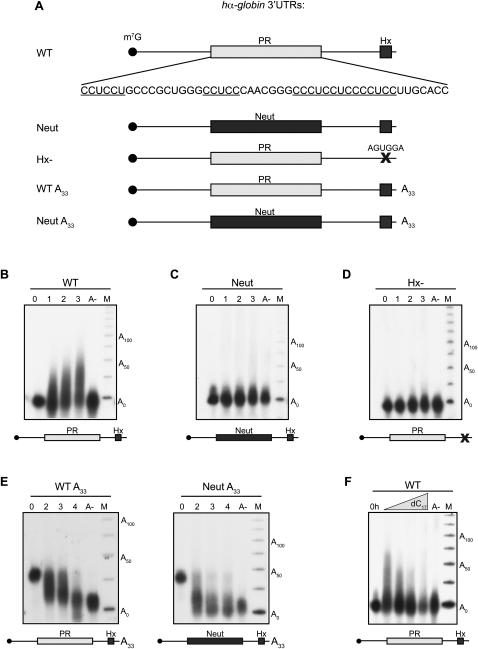FIGURE 2.
The hα-globin 3′ UTR is a substrate for αCP2-mediated cytoplasmic polyadenylation when injected into Xenopus embryos. (A) α-globin 3′ UTR RNAs used in this figure. PR denotes the 42-base C-rich stability determinant in the hα-globin 3′ UTR that is bound by αCP (Waggoner and Liebhaber 2003b). Neutral denotes a 42-base segment originating from the coding region of the α-globin mRNA that is substituted in place of the PR. Hx denotes the AAUAAA cleavage and polyadenylation hexanucleotide. X denotes the mutation of the cleavage and polyadenylation hexanucleotide from AAUAAA to AGUGGA. A33 denotes a 33-base (A) tail that is present on the synthetic RNA at the time of injection. All RNAs are synthesized in vitro in the presence of m7G cap and are [32P] internally labeled. (B–E) Polyadenylation assays. The specified 3′ UTR construct was injected into stage II embryos. RNA was extracted from aliquots of embryos after a 0-, 1-, 2-, or 3-h incubation, and the size of the labeled hα-globin 3′ UTR was determined on a denaturing acrylamide gel. An aliquot of RNA from the 3-h sample was also treated with RNase H in the presence of oligo dT to remove the poly(A) tail prior to analysis (lane A-). The marker lane (M) contains a [32P] end-labeled 25-nt single-stranded DNA ladder. (B) WT. The WT α-globin 3′ UTR is a substrate for cytoplasmic polyadenylation. (C) Neut. Replacement of the PR by a neutral sequence abolished cytoplasmic polyadenylation. (D) Hx-. Mutation of the AAUAAA cleavage and polyadenylation site to AGUGGA abolished cytoplasmic polyadenylation. (E) Deadenylation assays show that the presence of the PR sequence results in a net slowing of poly(A) tail shortening. WT A33 (left) and Neut A33 (right) α-globin 3′ UTRs containing A33 tails were injected into two-cell embryos in the same manner as carried out for the polyadenylation assays. RNA was isolated at hourly intervals over 4 h and sized on a denaturing gel. The input A33 RNA and the deadenylated input (A-) were loaded in the lanes 1 and 5, respectively, for size comparison. (F) Polyadenylation of WT hα-globin 3′ UTR is blocked by co-injection of unlabeled oligo dC. The WT 3′ UTR was assayed for polyadenylation in Xenopus embryos in the presence of increasing amounts of co-injected oligo dC17. RNA was isolated from each sample 3 h after injection. Experiment was carried out as in B.

